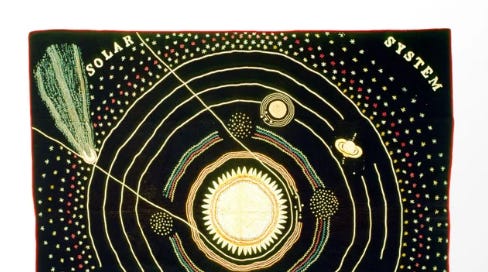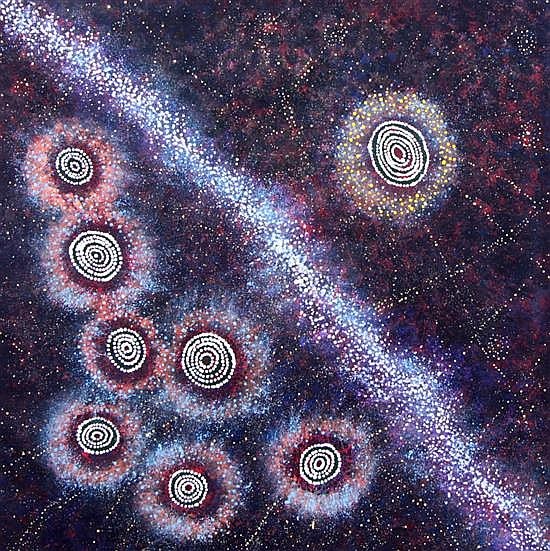I found myself down another rabbit hole. While scrolling on Instagram, I was stopped at an image that looked like a primitive, possibly aboriginal, black and white circular composition. It was posted by “womensart1”. This feed on Instagram often takes me into a journey of discovery about another artist who was extraordinary but very far from famous.
Down the rabbit hole" is an English-language phrase which refers to getting deep into something, or ending up somewhere strange. Lewis Carroll introduced the phrase as the title for the first chapter of Alice's Adventures in Wonderland. In the age of the internet, the term is associated with getting lost in online research.
“Solar System” was the name of a quilt created as a teaching tool by Ellen Harding Baker, an American astronomer and a teacher. Mrs. Baker was a remarkable woman. She was born in 1847. She married at the age of 22 to Marion Baker from Cedar County, Iowa. During the 1870s the family moved to Longtree in Johnson County Iowa where Mr. Baker had a general store and she worked as a teacher. They had seven children.
Mrs. Baker began creating her now famous quilt in 1876. (The reason that that date is known was because she thoughtfully embroidered 1876 in the lower right hand corner of quilt as it’s birthday.) She finished the quilt in 1883. Her quilt was mentioned in September 1883 in the New York Times, which quoted an Iowa newspaper. The Iowa newspaper reported that “Mrs. Baker of Lone Tree had just finished a silk quilt, which was seven years in the making. The quilt accurately depicts the solar system.”
The “Solar System Quilt” is held in the collection of the Smithsonian institute. It is made of silks and beautifully embroidered. At the center of the design is the sun. Radiating out from the sun are the eight planets. Mrs. Baker included the stars and the moons of Jupiter as well as the moons around Earth, Saturn, Neptune, and Uranus. The objects at the outeredges spill off the edges of the composition, which to me implies that there is more to be discovered.
This early women in the sciences has left her mark. One of the Instagram comments about Mrs. Baker said that she was a contemporary of the women’s star counters at the Harvard observatory in the 1870s when Harvard College Observatory began hiring women assistants. Mrs. Baker is mentioned in a book called The Glass Universe written by Dana Sobell. Jennifer Harris authored a children’s book She Stitched the Stars: A Story of Ellen Harding Baker.
What I see as an artist in Mrs Bakers quilt is a beautiful, primitive, and almost magical composition that fits into the history of art created to document the celestial heavens. The oldest known example that portrays the sky and the solar system is the “Nebbra Sky Disk”. It was discovered in eastern Germany 20 years ago. It’s a 12 inch bronze circle inlaid with gold strips that seem to depict the moon and the sun. It’s unclear whether it was a religious object or served in some sort of functional way.
Aboriginal people have a very detailed understanding of the solar system. Their extensive knowledge is based on both observation and record keeping in the form of dot painting, about the movement of celestial bodies in the sky. They’ve kept these records over multiple generations. These first peoples see the sky as a map.
Contemporary, aboriginal artist Alma Granites uses native celestial mythology in her series of paintings called Seven Sisters Dreaming. The subject stems from a story of seven sisters chased by a man in love with all of them. To escape him they turn into fire and ascend into the heavens to become stars.
Last year I was drawn down the rabbit hole of science and the study of planets, when I entered a juried exhibit called “Fierce Planets”. The exhibition debuted at Louisiana State University. The art works were displayed alongside a collection of objects held in by the departments of physics, geology, geophysics and astronomy.
Fierce Planets was a collaboration between the exhibition committee and Dr. Sabine Stanley, a Johns Hopkins University professor who studies planets, exoplanets, and asteroids. I was intrigued how Dr. Stanley was described in the entry information:
Dr. Stanley was raised in a town built on a nickel-lined crater formed by a speeding meteor’s crash and was a pink-haired space fiction fan at a young age. She’s now one of the leading global researchers who unearth the facts about materials and forces in and around planets, exoplanets, and asteroids to better understand how they impact our lives and our Earth’s future.
It was the “pink-haired sci-fi fan” that made me take the leap and create an entry. I immediately began looking into how young children get introduced to science. As a retired teacher, I am aware of the importance of conceptual structures in education. In science one of the common structures for lesson planning is “inquiry based learning”. This begins with asking a question, followed by investigation. The investigation leads to observation and recording. In the end to discovery.
Children naturally ask a lot of questions after they have observed something that interests them. “Inquiry” is innate. This idea of sparking a students innate interest was the beginning of my concept for my entry “A Sense of Wonder”. The figure on the lower left is a picture of my grandson at Christmas when I bought him explorers kit which included binoculars and a magnifying glass. Behind him is an imagined trip of discovery beyond earth.
At the time he began his fascination with bugs. Specifically, he loves to find scorpions and spiders. Since his grandparents live in the desert southwest where these creatures are abundant, he has lots of places to search for specimens.
The magnifying glass was very handy that Christmas. At night he would explore around our property and into the park with his grandfather using a blue light to find scorpions. He brought a few back in some old pill bottles. The next day would take out that magnifying glass and tell me all about the parts of the scorpion.
When I asked him, how did you learn so much about scorpions? His reply while he rolled his eyes was “Google Nana. Google!”. It seemed he too had gone down a rabbit hole of discovery. Maybe my grandsons interest in this subject will lead him, just like it did Dr. Stanley; to a career that began with something that captured his interest as a child.
Until next time
Margaret










Extraordinary information and talent. Amazing to learn all of this. It is worth finishing a quilt ... even if it takes 7 years or more. What an extraordinary quilt. Great archival photo also of the women in the library doing research.
Thanks for taking us on a solar journey on this full moon, partial lunar eclipse day. Unfortunately there was cloud cover here.